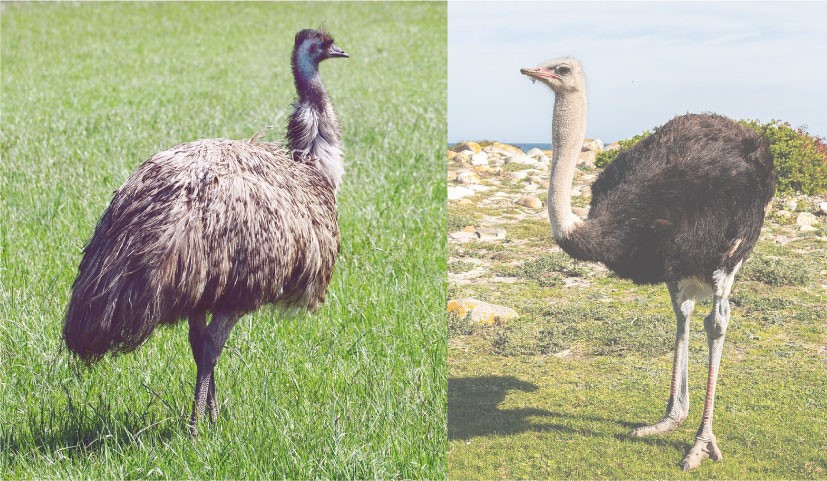SCORES & OUTDOORS: Don’t look now; what’s the difference between an emu and an ostrich?
 by Roland D. Hallee
by Roland D. Hallee
I’m going to try to spare you from having to listen to old people talk about their aches and pains. But, I have to explain something first.
While in the early stages of my seventh decade, like everyone else of my generation, we have aches and pains that appear from time to time. I happen to have one in my neck (no, not my wife).
I’ve tried various things, but my oldest brother put me on to a product called Blue Emu. I’ve seen it advertised on TV with baseball Hall of Famer Johnny Bench as the pitchman. Why should I doubt Johnny Bench? My brother swears it works. I decided to try it, since everything else seemed to be an exercise in futility.
The salve is made from emu oil. Whatever that is.
I have also seen commercials on TV featuring Limu Emu, an insurance selling emu for Liberty Mutual Insurance. I especially identify with the one where his caretaker is making a speech, with his wife, and what I would guess is the emu’s wife in the audience.
Looks like an ostrich to me. So what are the differences between an emu and an ostrich?
Well, for starters, the two largest birds in the world are the emu and the ostrich. Both are flightless birds but they compensate by being extraordinarily fast runners. Emus and ostriches somewhat resemble each other as they are both big, feathery birds with long necks and legs. So how, then, can we tell these two birds apart? Read on and we’ll discuss the differences between them.
The emu is the second largest bird in the world. This bird is native to Australia. Both male and female emu have deep brown feathers. They have long necks, very strong legs and have three toes. Emus are fast runners and can run up to 30 mph. These birds live up to 10 to 20 years. When mating, a male and female emu pair up. The females lay greenish-blue eggs weighing around one pound each. After laying the eggs, the female passes on the responsibility to the males. The male emu is the one in charge of incubating the eggs and taking care of the chicks.
Emus are known for the oil they produce, which is taken from their fat. This oil is noted to be effective in reducing inflammation and healing wounds and muscle aches. (Now we have discovered the healing properties of emu oil.) Emus are also farmed for their meat and leather.
The emu has a prominent place in Australian Aboriginal mythology, who say the sun was made by throwing an emu’s egg into the sky.
The ostrich is the largest bird in the world and is native to Africa. The male ostrich has black feathers with white wing tips. The females have grayish-brown feathers. They have long necks, extremely strong legs, and two toes. Ostriches can run up to 40 mph. They also have very large eyes. Ostriches are the ratite (meaning large, flightless birds) relatives of the emu. An ostrich can live up to 40 to 50 years. When mating, a male ostrich forms a group and mates with six to seven females. Female ostriches lay large white eggs weighing around three pounds each. The most dominant female and the male take turns in the incubation of the eggs. The female is in charge during the day since its feathers adapt to the environment at daytime. The male, on the other hand, is on duty at night using its black feathers as an effective camouflage.
Ostriches are farmed mainly for their feathers. These are used as dusters and for decorative purposes. Ostriches are also raised for their meat and leather.
During mating season, only a pair of male and female emus bond together. The male emu is the one in charge of the incubation and caring for the chicks. The ostriches, on the other hand, have shared responsibilities between the male and the most dominant female. The female’s duty is at daytime and the male sits on the eggs at night.
Oh, by the way, contrary to common myths, ostriches don’t bury their heads in the sand – they wouldn’t be able to breathe! But they do dig holes in the dirt to use as nests for their eggs. Several times a day, a female puts her head in the hole and turns the eggs. So, it really does look like the birds are burying their heads in the sand! The myth goes on to say that an ostrich does that to make itself think it is not visible when its head is in the sand.
Now, when I see Limu Emu in that insurance commercial, I will know the difference between the two. When you come right down to it, there really isn’t much of a resemblance at all.
Have you heard the one about a male ostrich who comes upon a group of ostriches that have their heads buried in the sand, and proclaims, “Where did everybody go?”
I guess you had to be there.
Roland’s trivia question of the week:
Which NASCAR driver has won the most Daytona 500s.
Responsible journalism is hard work!
It is also expensive!
If you enjoy reading The Town Line and the good news we bring you each week, would you consider a donation to help us continue the work we’re doing?
The Town Line is a 501(c)(3) nonprofit private foundation, and all donations are tax deductible under the Internal Revenue Service code.
To help, please visit our online donation page or mail a check payable to The Town Line, PO Box 89, South China, ME 04358. Your contribution is appreciated!



Leave a Reply
Want to join the discussion?Feel free to contribute!